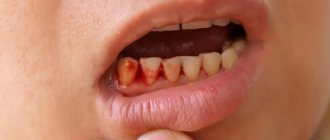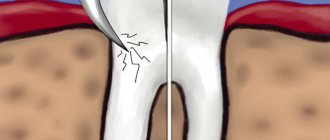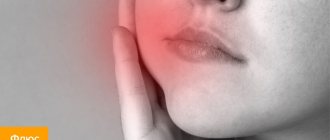05.08.2021 613
There are a large number of reasons why a person could potentially suffer such an injury. In this case, there can be a lot of unpleasant consequences - from a simple violation of aesthetics to severe pain, hypersensitivity to cold or hot food.
Let's look at why chips may appear and what the consequences are. We will also touch upon the issue of prompt home treatment in such a situation, as well as a method for solving the problem by a professional dentist.
The most common causes of chipped teeth
Human teeth are very strong. They are well protected from external mechanical influences and are designed specifically to cope with tough, fibrous foods. However, there are many factors that could potentially lead to chipping.
When you make an appointment with your dentist, he or she will conduct a thorough examination of your mouth and determine what may be causing the problem.
Typically, chips occur as a result of several common reasons:
- Inattentive food selection. You can chip a tooth when chewing if there is something too hard inside the food. It could be a small stone, a mollusk shell, and much more. The danger is especially great if you actively chew food and cannot sense in time that something is wrong.
- External trauma. Often happens when hit, fallen, or involved in a traffic accident. There is also a danger of collateral injuries. This may include tooth dislocation, gum damage, wounds on the tongue, or the oral mucosa.
It is also important to understand that the strength of a person's teeth may vary depending on many factors. There are several factors that significantly increase the likelihood of chipping:
- Violation of the acidity of the oral cavity.
- Enamel diseases.
- Cracks on the surface of the tooth.
- Severe damage to the seal.
- Malocclusion and other congenital deformities.
- Bruxism.
People with bad habits are also at risk. Excessive consumption of alcohol and smoking leads to teeth becoming much more fragile.
If a person belongs to a risk group, a chip may appear even from not the strongest pressure. Therefore, it is worth monitoring the condition of your teeth and taking timely measures. So, if you suffer from bruxism and grind your teeth a lot at night, you should choose mouthguards on the advice of your dentist to reduce the negative impact.
Some people also experience chipping simply because they are inattentive to their diet. They actively chew on candy and nuts and open their jaws too much while chewing food, which significantly increases the potential for injury.
Sometimes the problem takes on a systemic nature and indicates negative changes in the body, a lack of certain nutrients from food. In this case, the answer to the question of why teeth may break off specifically in your case is given by a comprehensive examination.
Types of chips
In clinical practice, there are several types of chips, differing in the tissues affected:
Chips within the enamel
Trauma and disruption of integrity occurs within the enamel. In this case, symptoms do not appear, even the chip itself may be invisible. But with significant chips, pain, increased sensitivity of the teeth, and a feeling of soreness may appear.
Chip within dentin
As a result of trauma, the dentin layer is damaged. Most often, the anterior group of teeth are damaged during falls and can be combined with other injuries. Chips within the enamel require timely treatment, otherwise complications will not be long in coming.
Chips involving the neurovascular bundle
These are significant chips of the enamel, which expose the pulp. Which is associated with severe pain, bleeding and other symptoms. In this case, urgent medical attention and treatment is necessary.
Signs of chipping
In most cases, chips can be identified by visual inspection or when the patient simply touches the tooth with his tongue. But there are also situations when the chip is located on the inside, difficult to reach and difficult to inspect.
Such situations reveal themselves as a whole list of symptoms. These include the following:
- Problems with chewing food, something constantly gets in the way, pieces begin to get stuck inside the tooth.
- The loss of a previously installed filling (a chip forms on the remaining part of the tooth and it simply cannot hold on normally).
- Severe sensitivity when eating - a reaction occurs to sour, salty, cold, hot foods.
- Acute pain and severe pulsation at the site of injury.
It is worth understanding that the size and nature of chips may vary. Because of this, some patients may not even notice the problem, while others experience severe pain - their nerve is exposed. Regardless of the degree of destruction, you should consult a doctor as soon as possible and conduct a detailed examination of the oral cavity.
Prevention of dental diseases
A number of simple steps will help the patient keep his teeth healthy for as long as possible and reduce the likelihood of diseases:
- Careful hygiene, brushing teeth at least twice a day.
- Using dental floss and rinsing with special solutions.
- Attention to the condition of soft tissues and gums.
- Timely visit to the dentist if alarming symptoms appear, preventive examinations twice a year.
How to pull a tooth at home without pain
How to relieve toothache at home
Main types of damage
The choice of treatment method directly depends on how badly the patient’s tooth is damaged. There are several common manifestations, which include the following:
Crack in the enamel.
- The enamel itself is very durable, which is not surprising - it acts as the main protective mechanism throughout life. There are many factors that can lead to the appearance of microcracks in the surface. From the outside, they are often very difficult to distinguish, but they can not only increase in size, but also become the cause of common oral diseases, such as caries. Food gets packed into the cracked areas and bacteria actively multiply in them. At the same time, the strength becomes less and the likelihood of a large chip only increases. The standard cause of the problem is an incorrect diet, eating a lot of sweets.
- Chipping of part of the enamel. A lacuna appears on the tooth, which is often clearly visible even during an external examination. There is pain and an acute reaction when eating various types of food. It is worth consulting a doctor as soon as possible to prevent the problem from getting worse.
- Skol. It differs in location and size. Depending on the nature of the injury, it appears on both the external and internal sides of the tooth and is clearly visible during the initial visual examination. The injury is accompanied by hypersensitivity, severe pain, pulsation and other noticeable negative manifestations.
Injuries in which the tooth is chipped at the root are also common. They are the most dangerous for humans, because in this case the nerve is exposed and the patient begins to experience severe physical suffering. Further actions in case of injury will depend on the condition of the remaining part of the tooth. Removal of the root is required, but sometimes it is possible to use the remainder as a base for a crown.
In our clinic, doctors fight for every tooth. We do everything to restore aesthetics, chewing ability and relieve you of pain.
Why chips appear - causes of damage
Injury can occur for a variety of reasons. This may be a simply unsuccessful attempt to crack the shell or, for example, the gradual destruction of the crown due to acute demineralization of hard tissues or constant mechanical stress. Thus, among all the potential prerequisites, dental experts identify the most common:
- mechanical injuries - resulting from a bruise, blow, fall or biting off hard food,
- abundant deposits of plaque and stone, caries - all this leads to deterioration of the enamel and hard tissues, contributing to their gradual destruction,
- demineralization - can be either a consequence of caries or the result of hormonal changes (for example, pregnancy), insufficient intake of vitamins and nutrients, pathological processes in the body, age-related changes,
- temperature and acid exposure - incisors are more susceptible to this, but cracks and chips can also appear on molars as a result of sudden temperature changes,
- malocclusion – in which the chewing load is distributed unevenly, causing increased pressure on individual elements,
- Bruxism is involuntary strong clenching of the jaws and grinding of teeth, mainly during sleep.
The cause of the chip may be untreated caries.
This is only part of the possible prerequisites that can lead to such a nuisance. A lack of vitamins and minerals, as well as some pathological conditions, lead to weakening and thinning of the enamel, the development of hyperesthesia, that is, its increased sensitivity. In this state, the top protective layer cannot properly withstand mechanical, temperature and other external influences.
“When I was pregnant, my gums became inflamed and my teeth began to crumble, it was a nightmare! And the enamel was so sensitive, it was impossible to drink hot tea. I constantly went to dentists. But this is, in principle, normal. My doctor said that due to hormonal changes, calcium is being washed out of the body. And gums also often become inflamed in pregnant women; gingivitis is generally a disaster...”
Tinatin, from correspondence on the woman.ru forum
Therefore, in order to reduce the risk of injury, you need to take care of the condition of your teeth and gums, periodically strengthen them with the help of specialized means, and be sure to regularly visit the dentist for preventive maintenance.
First aid at home for a chipped tooth
Sometimes the injury occurs late in the evening or it is impossible to make an appointment with a doctor the next day. In this case, you need to take the right steps to prevent infection, relieve pain, and rule out most other potential problems.
At home, several actions are taken depending on how severe your injury is and what signs it is accompanied by:
- Mouth rinse. Note that as soon as a tooth chips, you need to stop swallowing saliva until you rinse your mouth. Rinsing is done gently, without creating a vacuum or strong pressure on the affected side. To ensure quick disinfection, you can also use a chlorhexidine solution.
- Application of a special compress. This is necessary in order to minimize swelling. At home, use a towel soaked in cold water or a special ice bag, which we recommend keeping on hand. If there is no such bag, put the ice in a bag and wrap it with cloth. The same towel will work well.
- Taking painkillers. This allows for temporary relief of pain. If you do not have any contraindications, you can use products with an additional anti-inflammatory effect. These include such as Ibuprofen, Dolaren and others. When the patient does not have individual intolerance to drugs, and the chip is large, it is practiced to place a tampon soaked in lidocaine or novocaine inside. The measure is needed to significantly reduce pain and prevent pathogenic bacteria from entering the chipped tooth.
A special situation arises if a person experiences severe bleeding. In this case, rinsing is contraindicated. The tooth itself can be covered with a turunda for additional protection.
If you have a chip, you need to see a doctor as soon as possible. When a tooth is chipped at the root, we recommend saving the remaining part - it will be needed for subsequent restorative procedures.
It is not recommended to delay going to the doctor. The reason is that there is a high probability of infection and gradual further spread of the process.
What to do if a piece of a tooth breaks off
First of all, you need to visit a dentist. Panic is unacceptable, since the situation is fixable, and at the initial stage it is quickly corrected. A specialist should examine the oral cavity and assess the extent of the problem. If the damage is mild or moderate, it is advisable to carry out treatment in the coming days. If the pulp is exposed, you need to urgently go to the doctor on duty. Otherwise, the patient will not be able to eat, rest, or sleep normally due to unbearable pain.
Relieving symptoms at home
To reduce discomfort and relieve pain, it is necessary to organize pre-medical care. The remaining manipulations will be performed by professional doctors after a visit to the dental clinic. Procedure:
- Rinse your mouth with clean running water.
- To reduce swelling, apply a cold compress to the inflamed area. Apply a sterile bandage if bleeding occurs.
- Take painkillers.
If a piece of a tooth breaks off, the nerve hurts, or the root is split, you should not throw away the fragment of tissue; it is better to show it to a doctor. The fragment may be needed for subsequent restoration.
Emergency assistance before visiting the dentist
Immediately after the incident, urgent measures must be taken. All the steps listed above are mandatory: first, splinters and particles of food are removed by rinsing, then cold is applied to the gums to eliminate inflammation and discomfort, and oral analgesics are used.
Additionally, it is recommended to rinse the mouth with a weak antiseptic solution. To do this, you can use chlorhexidine, furatsilin or any other gentle composition.
Treatment by a doctor
There are several ways to repair a chipped tooth (how it is treated depends on the degree of damage and the presence of pain). Therapeutic intervention options:
- Artistic restoration. Special composites are used. Acceptable when breaking off small fragments.
- Installation of veneers and lumineers. Used for cracks, chips and formation of crevices.
- Recover using tabs. This is how a significant piece of bone tissue is reproduced.
- Prosthetics (crowns). Indicated when most of the dental unit is missing.
Types of professional medical care
When a patient sees a dentist, he carefully assesses the situation. Depending on the initial state, there may be many options for action. These include:
- Remineralization. This method is used if a small crack occurs in the enamel. Either an individual tooth or the entire row can be treated with a special strengthening preparation. A special product is used, which contains a sufficient amount of various trace elements and minerals. The technology allows you to get rid of cracks and significantly strengthen the tooth.
- Application of preparations with a high fluoride content. This is also necessary in order to significantly improve the overall condition of the enamel. The patient is prescribed a special mouthguard, onto which such material is applied. This makes it possible to provide treatment around the clock.
- Artistic restoration. This method is needed specifically to restore the aesthetics of the oral cavity. The method is used if the chip is small. Modern technologies are needed to restore the shine of enamel. The color of the restored fragment will not differ from the surrounding row.
- Installation of additional cover. One of the most common methods of restoring dental aesthetics without the use of complex and lengthy operations. We use various types of overlays – these can be lumineers and veneers. The composition, duration of use, appearance and many other characteristics differ.
- Placement of a special crown. The approach can be used if the upper part of the tooth is not severely damaged. The remaining part of the tooth in this case begins to be used as a natural support. The crown will be stable and will completely fill the vacated space.
- Using special tabs. At the same time, the order for the production of such an onlay is transferred to a special dental laboratory. The overlay is very durable and restores chewing ability.
Sometimes, as a result of strong pressure, the tooth root itself breaks. This is the most serious situation in which proper removal of tooth remains and subsequent implantation will be required. A base is installed in the gum, on which a special crown is fixed.
Restoration of a chip
If a chipped tooth causes aesthetic or physical discomfort, it can be restored. The method of its implementation depends on the characteristics of the damage.
Remineralization
The simplest restoration option is remineralization. If, as a result of a chip, only the enamel is damaged, then it can be strengthened with the help of special preparations. Their regular use allows not only to make the enamel surface thicker, but also to get rid of pain, such as reactions to cold, acid, etc.
Building up
Artistic tooth augmentation is the most popular method of treating chips. It allows you to build up hard tissue layer by layer, completely repeating the original shape of the dental crown. At the same time, the functionality of the tooth is also restored, thanks to which the patient can quickly return to their usual diet and lifestyle. Externally, the augmented tooth does not differ from other healthy teeth due to the competent selection of materials.
Filling and microprosthetics
If there is deep damage to the teeth, a filling may be prescribed. It makes it possible to completely close the crack, returning the tooth to its original appearance. It is important that the cavity is thoroughly cleaned and disinfected so that caries does not begin to develop under the filling.
If a piece of tooth enamel is completely broken off during a chip, microprosthetics will be the optimal treatment method. It includes the use of crowns made of different materials or more expensive and aesthetic devices - veneers.
To install such dentures, the tooth is additionally ground down. After it acquires the required dimensions, the microprosthesis is attached to the enamel using a special fixing solution.
Chip in the front row of teeth
Typically, such chips occur when biting or a strong blow. Even the smallest defects are noticeable on the front row, so a small chip can cause not only discomfort, but also psychological problems. Also, the aesthetics are spoiled by microcracks, which over time begin to turn black and become more and more visible.
When small cracks appear, fluoridation and mineralization are usually sufficient. If the enamel has been severely damaged and part of the tooth has broken off, installing an artificial veneer would be a good solution. In our clinic, your dentist will install veneers or ultraneers for you. If the damage is severe, the only option is removal, prosthetics or implantation.
Types of chips
There are different types of injuries, but their main classification involves division by depth and scale of damage. Experts identify an enamel chip - a minor superficial violation of the integrity of the crown. But if a tooth breaks off at the root, dentin and even pulp may already be affected. The case is serious, and urgent assistance from a specialist is needed here. In case of deep damage that seriously affects the root system, the tooth will have to be completely removed and an implant with a crown or a bridge will be placed in its place.
The photo shows chips that affected the dentin and pulp of the tooth.
Chip on the side of the tooth
Most often occurs during chewing. Since this is a side invisible to prying eyes, many patients decide not to see a doctor at all and live with such a defect.
This approach is wrong for several reasons:
- A chip can easily become a site for the development of caries and the situation will only get worse.
- Due to the strong pressure on the damaged area, further destruction is possible.
- There is a risk of injury to the tongue when it comes into contact with a sharp edge and the onset of an inflammatory process.
The advantage of working with the sides is that aesthetics matter less. Therefore, you can get by with less expensive materials during the restoration process. The strength itself will not become lower.
Causes of injury
The lining of the oral cavity is very delicate. Even a slight impact violates its integrity. Any damage leads to infection. The severity of the damage, as well as the clinical picture, depend on the strength of the impact and on the characteristics of the body. The most common type of damage diagnosed is mechanical. Constant injury to the cheek by teeth is dangerous. Based on the depth of the lesion, the following types of pathologies are distinguished:
- Hemorrhage inside tissues, that is, hematoma, when their integrity is not broken;
- Erosion after injury;
- Decubital ulcer;
Most often, erosions occur in irregular shapes. They are covered with a thin whitish-yellow coating. Ulcers, as a rule, are single, there is no swelling around them, they become moderately painful. Their bottom and edges are covered with a fibrinous film. The usual localization of ulcers is the inner side of the cheeks, tongue. With prolonged absence of therapy, their bases and edges become denser. Common causes of damage:
- In babies in the first months of life, the mucous membrane is affected due to premature eruption of the masticatory organs. Since their dentin, the enamel layer, is underdeveloped, the frenulum, the lower part of the tongue, is injured when sucking. Disruption of the epithelial layer causes inflammation.
- Biting lips and cheeks after anesthesia form abnormalities. In addition, children are often injured by stuck plates of apple cores.
- People with increased nervousness may bite their cheeks, tongue, or lips. They often bite pencils and pens.
- The provoking factor for injury may be the sharp edge of the crowns.
- Damage occurs from overhanging edges of fillings, from wire splints, from ligatures, from wearing orthodontic systems.
- Mechanical damage occurs in people who wear improperly installed veneers.
- Accidental biting occurs when eating in a hurry.
- Patients often consult a doctor with occlusion problems, carious cavities, and dilapidated crowns.
- The causes of injury include chips, fractures of masticatory organs, and remnants of roots.
The oral cavity in children can be damaged by sharp toys, household items, and exposure to various bad habits. Defects occur during coughing, when the tongue is pressed tightly against the sharp parts of the lower units.
Occurrence of a vertical crack
Sometimes a chip does not appear, but the tooth cracks vertically - this is very noticeable from the outside. The choice of treatment method will be based on how severely the enamel is damaged and how deep the crack goes.
There are three main treatment options:
- Standard filling.
- Installation of external onlays on the tooth.
- Removal and subsequent implantation.
It is important to resolve the problem quickly before numerous potential complications arise.
Why wedges form on teeth and what to do about it
The defect can develop on both the upper and lower jaw, on one or more teeth. Most often, canines and premolars are affected - namely, they experience a large chewing load. The disease develops gradually and unnoticed. Over time, the defect deepens into the dentin, and the person feels pain. If the problem continues to be ignored, the base of the tooth becomes so thin that it can break.
A wedge-shaped defect appears in people of different ages, including teenagers. However, the older the person, the greater the risk of developing pathology.
The moment of appearance of the wedge-shaped defect cannot be tracked independently. But if you undergo regular examinations with a dentist, treatment will begin on time and will be completed with minimal time and money.
At first glance, a wedge-shaped defect can be confused with cervical caries. The affected teeth are marked with triangular-shaped spots and depressions, up to 4 mm in depth in the acute stage of development.
As for where wedges on teeth come from, there are three generally accepted theories:
- Chemical. The culprit is aggressive acids from food, drinks and resulting from an imbalance in the acid balance of the oral cavity.
- Mechanical. The defect is caused by an external load.
- Physico-mechanical. Pathology develops in response to improper chewing load.
Do children need to treat chipped teeth?
Parents often ask the question of what to do if a child’s tooth chips. Many people believe that baby teeth are not that important and therefore need not be treated. The logic is simple - they will fall out on their own and be replaced by indigenous ones.
But you should not be guided by this logic for a simple reason - the condition of the baby tooth greatly affects the formation of the molar. The onset of the inflammatory process and infection of the tooth lead to inflammation of the gums. This can negatively affect the formation of permanent dentition.
Special cases
Some teeth are restored in their own ways. Let's look at them.
Wisdom tooth
If a chip appears on this tooth, it is not restored. The procedure makes no sense. The fact is that this chewing organ is not involved in the chewing process and is not important for the species. Dentists remove a chipped wisdom tooth.
Front tooth
The situation with chipped front teeth seems deplorable to public citizens. In this case, the dentist may offer different treatment methods. For example, artistic restoration. The dentist will use a paste to select the desired color and restore the tooth. The material is resistant, durable and imitates naturalness well. The doctor will fix the applied layer with special light radiation. It is impossible to determine from the appearance that the patient’s tooth has been restored using extensions.
The second way to restore a tooth is to use a veneer. It is used for serious injuries. The material is strong, resistant, durable and does not change color over time.
In the third case, they resort to installing a crown. For these purposes, zirconium oxide, ceramics or metal ceramics are used. The choice of material is influenced by the patient’s opinion and ability to pay.
Lateral teeth
The same restoration methods can be used on the side teeth as on the front teeth. However, this is not entirely justified. These teeth are hidden from the eyes of others. Therefore, to restore them, you can use a regular filling. But it is better to resort to the extension method. Veneers are not installed on lateral teeth.
If a nerve has opened up on a side tooth, the dentist will first do an antiseptic treatment, perhaps remove the diseased nerve or the entire tooth and make a new one again.
Baby tooth
A parent often makes the mistake of thinking that it is not worth taking a child to the hospital with baby teeth. It's in vain. If your baby teeth are chipped or cracked, your doctor will stop further decay using a filling or preservative gel. For chipped incisors, a special gel is mainly used. Healthy baby teeth will lead to healthy permanent teeth.
Children are especially often injured. This happens due to falls or blows. The resulting chips lead to further stomatitis and increase tooth sensitivity. Therefore, a visit to your pediatrician is important.
It is important for the child to carry out the following pre-medical measures:
- Calm a frightened child.
- Give your child water to rinse his teeth.
- If soft tissues are damaged, disinfect them.
- Be sure to save the broken tooth for the doctor.
Within the first 24 hours, a child with a chipped tooth should be shown to a doctor. During the appointment, the doctor will most likely take pictures of the baby, which will help check the condition of the roots and soft tissues. For chipped incisors, a special gel is mainly used.
Special case - vertical crack
The vertical crack does not appear to be dangerous. It's a lie. It seriously hurts the pulp. As a result, it is not possible to restore the enamel with a filling. In serious cases, the patient feels that one half of the tooth is loose. In serious cases, the patient feels that one half of the tooth is loose.
In the case of a small crack, pressure is applied to the teeth. As a result, the tissue gradually loses its integrity. The result of this state of affairs is a big chip. If you go to the dentist, they will cover up a small crack, thereby restoring the enamel and health. If this action does not help, the doctor may install veneers or a crown.
What complications can you encounter due to chips?
If you notice a chip on your tooth, you should contact your dentist as soon as possible to have it repaired. And it's not just about aesthetics. Delay will cost the health of your smile. There are several potential complications that have to be encountered in medical practice:
- Tooth infection. Any pathogenic bacteria can penetrate through the open pulp. As a result, the person not only suffers from pain. Previously, only a slightly damaged tooth that could still be saved had to be removed.
- Periodontitis. This is the name of a strong inflammatory process that occurs in the tissues surrounding the apex of the tooth root. Treatment is long and complex and may require removal.
- Formation of neoplasm. They can be of either granulosa or cystic type and pose a serious danger to the human body.
- Changes in bite and dental mobility. It is formed due to the fact that it becomes inconvenient for a person to close his jaws. There are many types of complications due to this reason.
The development of severe sensitivity to food, which over time develops into pain, is also characteristic. You cannot delay treatment - contact a doctor as soon as possible.
Prevention
Taking care of your oral health in a timely manner is much easier, cheaper and painless than treating a chipped tooth. A few simple tips will help make your teeth strong and prevent chips and fractures:
- Care for your mouth regularly, use rinses and dental floss after meals. It wouldn't hurt to have your teeth professionally cleaned.
- Do not overeat too hot or cold food and, especially, do not mix them.
- Get rid of bad habits - biting nails, pencils, biting threads.
- Eat well, include calcium, magnesium and vitamins in your diet.
- Limit your intake of sweet and sour foods.
- Visit your dentist 1-2 times a year to replace old fillings, put in new ones, get rid of tartar and get advice.
If a tooth breaks or chips, do not put off going to the dentist. The defect may be more serious than it seems at first glance. Some fractures, for example those with a crack at the root, should never be ignored. Only a specialist can assess the real extent of the damage.
Don't forget that disease is easier to prevent than to cure.
Take care and strengthen your teeth - the stronger they are, the less susceptible they are to chips and fractures. The doctor's consultation
How to prevent chipping
There are several tips that dentists give to patients in order to keep their teeth intact for as long as possible. These include:
- Maintain good oral hygiene. Use high-quality pastes, rinses, special gels as recommended by your doctor. The enamel needs to be strengthened.
- Visit your dentist regularly. It is necessary to carry out proper dental treatment, to ensure that the enamel does not crack or wear off.
- Monitor the condition of the gastrointestinal tract and other body systems. Particular attention should be paid to the functioning of the endocrine and immune systems. Changes in the balance of acidity in the oral cavity should not be allowed.
- Form your diet correctly. It should include foods that stimulate strong bones and teeth.
- Correct your bite. Due to improper bite, chips appear quite often, and the enamel itself is worn away ahead of time. It is cheaper to get braces than to periodically spend money on veneers, implantation, remineralization and other dental procedures.
- Cure bruxism. This may require you to wear special mouthguards.
Equally important is the advice to monitor what and how you eat. Try not to chew on anything too hard—candy, nuts, and more. If you chew carefully and watch what you eat, the likelihood of chipping will be much less.
How necessary is treatment?
Treatment of chips is not always necessary.
If we are talking about minor damage, then it is often enough to carry out an inspection, make sure there are no deeper cracks and, if the chipped tooth enamel has sharp edges, grind it. After this, the patient is advised to monitor his oral health more closely so as not to repeat a similar incident. In some cases, if the damage is of moderate severity, additional filling may be required. For this, standard composite materials are used.
Severe enamel damage
If the chip is deep, the doctor may recommend comprehensive treatment. It involves removing the pulp and filling the canals. After this, the cavity is closed with a filling or crown. This approach eliminates the entry of infection and harmful microorganisms into the tooth cavity, thereby keeping it healthy and functional.
We will quickly and efficiently deal with chipped teeth
At our clinic, doctors are ready to quickly treat chipped teeth and any other injuries or damage. We use advanced techniques - from remineralization to installation of onlays and implantation.
We offer our clients affordable prices and are always ready to answer any questions they may have. We will relieve you of pain, restore the aesthetics of your smile and the ability to chew normally. We have affordable prices and special offers.
To learn more about the treatment process and make an appointment with a dentist at a convenient time, leave a request on the website or call us at the numbers provided.










